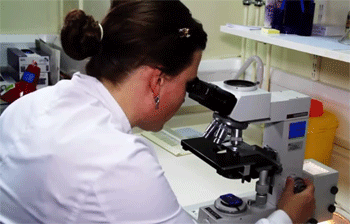Scientists collaborate to reduce number of animals needed for breast cancer research

More than 200 scientists have signed up to a tissue-sharing database designed to reduce the number of animals needed for biomedical research.
SEARCHBreast, an initiative led by the University of Leeds in collaboration with the University of Sheffield, allows breast cancer researchers across the world to search for remaining mouse tissue from previous experiments.
By using this tissue, there is no need to rely on new animals, reducing the overall numbers used.
Professor Ingunn Holen, from the University of Sheffield's Department of Oncology and Metabolism, said: "Researchers in Sheffield have been keen to sign up to SEARCHBreast as this pioneering initiative provides the first mechanism in the UK for the sharing of archival material in this way.
"Sheffield is a leading centre for breast cancer research and internationally recognised for work on how the disease spreads to other parts of the body. Part of this important research requires the use of animals and the material generated is a valuable resource that can be shared with the scientific community."
SEARCHBreast is led by Professor Valerie Speirs, Professor of Experimental Pathology and Oncology in the School of Medicine at the University of Leeds.
"As scientists, we are always looking for ways to reduce the number of live animals we use in research," said Professor Speirs.
"In oncology though, and particularly breast cancer research, the best option we currently have to study how tumours develop and respond to drugs is animal tissue, so animals have to play a part.
"An example of how this translates to human benefit is tamoxifen, a drug which has saved the lives of millions of people diagnosed with breast cancer; its approval as a clinical therapy was aided by important work with rodents conducted in the 1970s."
While several mice are usually needed to produce reliable results, in general only a fraction of each tissue sample is required to perform an experiment. Scientists typically store the rest of the material away, which is often not re-visited.
"SEARCHBreast brings together those who need animal tissue and those who are holding it in their archives," added Professor Speirs.
"Most scientists are willing to share this material on a collaborative basis, and it makes ethical, economic, and academic sense to do that.
"It serves the goals of the 3Rs - the Reduction, Replacement, and Refinement of the use of animals in biomedical research."
Now the success of SEARCHBreast, which is also run in collaboration with the Barts Cancer Institute and Cancer Research UK Beatson Institute at the University of Glasgow has been highlighted in a commentary in the journal PLOS Biology.
Since its launch in 2014, 220 scientists from the UK, EU, US and Australia have signed up to SEARCHBreast and nearly 90 animal models are available, representing thousands of ready-to-use tissue samples.
Plans are now underway to extend the framework beyond breast cancer research.
Professor Speirs said: "We want to foster a culture of collaboration, and by doing this, we're reducing the number of animals needed for research all round.
"We have shown this concept works for breast cancer and our research shows a desire from scientists in other disciplines to adopt SEARCH in their own field."
SEARCHBreast is funded by the National Centre for the Replacement, Refinement & Reduction of Animals in Research.
More information: Morrissey B, Blyth K, Carter P, Chelala C, Jones L, Holen I, et al. (2017) The Sharing Experimental Animal Resources, Coordinating Holdings (SEARCH) Framework: Encouraging Reduction, Replacement, and Refinement in Animal Research. PLoS Biol 15(1): e2000719. DOI: 10.1371/journal.pbio.2000719
Journal information: PLoS Biology
Provided by University of Sheffield



















